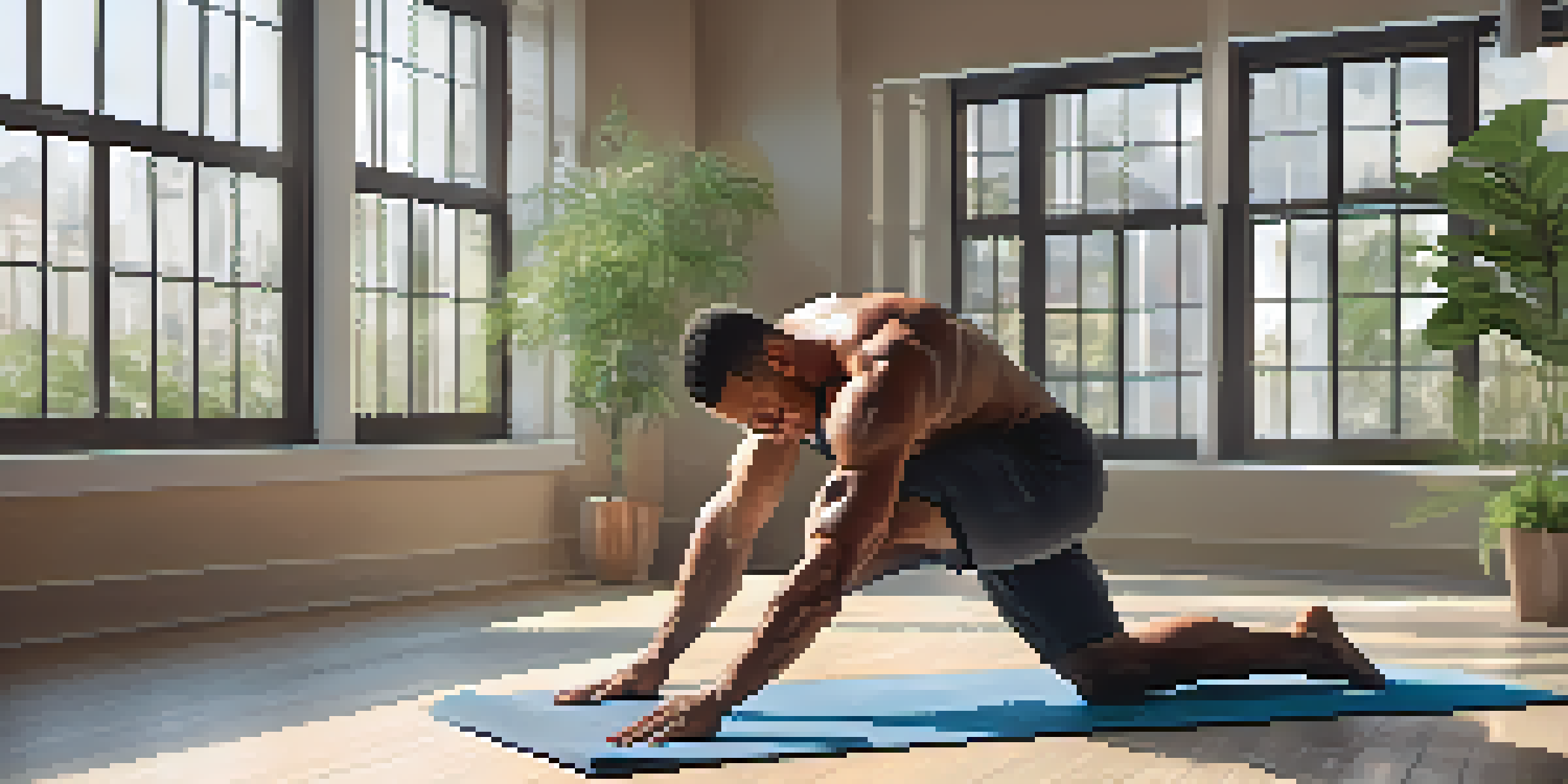Incorporating Flexibility Training into Bodybuilding Regimens

Understanding Flexibility Training and Its Benefits
Flexibility training involves exercises that stretch muscles and improve the range of motion in joints. This type of training is essential for overall athletic performance and can complement bodybuilding by enhancing muscle function. By incorporating flexibility exercises, bodybuilders can experience improved posture, reduced injury risk, and better muscle recovery.
Flexibility is the key to stability.
For example, engaging in regular stretching helps alleviate tightness that can develop from repetitive weightlifting movements. By loosening these muscles, bodybuilders can lift more effectively and efficiently. Additionally, flexibility training can lead to better muscle symmetry, which is crucial for aesthetic appeal in bodybuilding competitions.
Ultimately, flexibility training not only boosts performance but also enhances the enjoyment of workouts. By feeling more limber and agile, bodybuilders can approach their routines with a refreshed mindset and greater enthusiasm.
The Role of Flexibility in Muscle Recovery
Incorporating flexibility training into bodybuilding routines can significantly enhance muscle recovery. After intense workouts, muscles can become tight and sore, leading to decreased performance in subsequent sessions. Stretching helps to alleviate this tightness and promotes blood flow, which is essential for delivering nutrients to recovering muscles.

For instance, post-workout stretching can help flush out lactic acid, a byproduct of intense exercise that contributes to muscle soreness. By dedicating just a few minutes to stretch after lifting, bodybuilders can reduce recovery time and get back to their training sooner. This not only improves physical recovery but also encourages a more consistent workout schedule.
Flexibility Boosts Muscle Recovery
Incorporating flexibility training helps alleviate tightness and promotes blood flow, enhancing muscle recovery after intense workouts.
Moreover, flexibility training can help bodybuilders listen to their bodies better. Being in tune with muscle tension and tightness can guide adjustments in workout intensity and frequency, ultimately leading to more effective training outcomes.
Key Flexibility Exercises for Bodybuilders
When it comes to flexibility training, bodybuilders should focus on key exercises that target major muscle groups. Some effective movements include dynamic stretches before workouts, such as leg swings and arm circles, and static stretches afterward, like hamstring stretches and shoulder stretches. These exercises help maintain a full range of motion in the muscles used during lifting.
The more you stretch, the more you can stretch.
For example, incorporating a routine of hip flexor stretches can be particularly beneficial for bodybuilders, as tight hip flexors can hinder squat depth and overall leg performance. Similarly, chest openers can counteract the tightness that often develops from bench pressing. By integrating these targeted stretches, bodybuilders can ensure their muscles remain supple and responsive.
Additionally, yoga can be a fantastic way to enhance flexibility while promoting mindfulness. Many bodybuilders find that incorporating yoga sessions into their weekly routine not only improves flexibility but also offers mental clarity and stress relief.
Creating a Balanced Training Schedule
To effectively incorporate flexibility training into a bodybuilding regimen, it's essential to create a balanced training schedule. This means dedicating specific days or times during workouts to focus on flexibility, rather than treating it as an afterthought. For instance, setting aside time after each lifting session for stretching can ensure that flexibility becomes a regular part of the routine.
A good practice is to allocate at least 10-15 minutes for flexibility work post-workout, while also considering a dedicated flexibility day. This could involve a yoga class or a structured stretching routine that targets all muscle groups. By prioritizing flexibility, bodybuilders can enhance their overall performance and progress.
Key Exercises for Bodybuilders
Targeted flexibility exercises like hip flexor and shoulder stretches can significantly improve range of motion and overall lifting performance.
Additionally, tracking flexibility improvements through regular assessments can help maintain motivation. Bodybuilders may find it rewarding to note how their range of motion improves over time, further emphasizing the importance of flexibility in their training journey.
Listening to Your Body: Flexibility and Intuition
One of the most important aspects of incorporating flexibility training is learning to listen to your body. Every body is different, and what works for one person may not necessarily work for another. When you notice tightness or discomfort in specific areas, it may be a sign that you need to focus more on flexibility for those muscles.
For example, if a bodybuilder feels tightness in their shoulders after a heavy bench press, it might be beneficial to add more shoulder stretches to their routine. Being intuitive about your body’s needs helps tailor flexibility training to enhance overall performance and comfort during workouts.
Moreover, regular self-assessments can illuminate areas that may require more attention. By being mindful of how your body feels during and after workouts, you can adjust your training accordingly, ensuring that flexibility training becomes a valuable component of your bodybuilding journey.
Common Misconceptions About Flexibility Training
There are several misconceptions surrounding flexibility training, especially within the bodybuilding community. One common belief is that flexibility training is only necessary for athletes in certain sports, but this is far from the truth. Bodybuilders, too, can benefit immensely from improved flexibility, which can enhance their lifting techniques and overall performance.
Another misconception is that flexibility training will make bodybuilders less powerful or strong. In reality, improved flexibility can lead to better muscle engagement and control, allowing bodybuilders to lift more effectively. It's important to understand that flexibility and strength complement each other rather than compete.
Listening to Your Body Matters
Being intuitive about body tightness allows bodybuilders to tailor their flexibility training, optimizing performance and comfort.
Additionally, many people think that flexibility training requires a lot of time and effort, deterring them from incorporating it. However, even short, consistent stretching sessions can yield significant benefits, making flexibility training accessible and manageable for everyone.
Measuring Progress in Flexibility Training
Tracking progress in flexibility training is essential for maintaining motivation and recognizing improvements. Bodybuilders can measure flexibility in various ways, such as assessing their range of motion in specific stretches or noting how easily they can perform certain movements. Keeping a journal or using mobile apps to log these measurements can provide tangible evidence of progress.
For instance, if a bodybuilder can reach further in a hamstring stretch over time, it's a clear indicator of improved flexibility. Regularly assessing progress can also help identify areas needing more focus, allowing for adjustments in training routines as necessary.

Furthermore, celebrating small victories in flexibility can boost overall morale. Bodybuilders may find that as they improve their flexibility, they not only enhance their lifting capabilities but also gain greater enjoyment from their workouts.